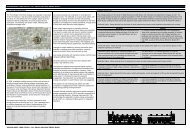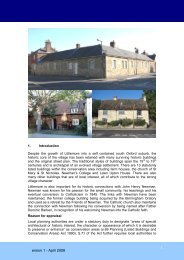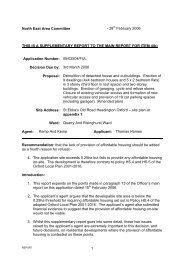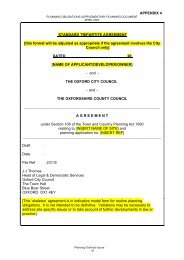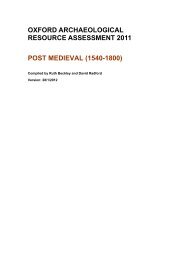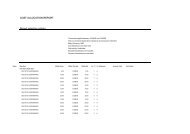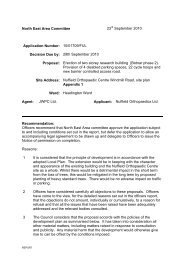Palaeolithic to Mesolithic Oxford (500000 - 4000 BC) - Oxford City ...
Palaeolithic to Mesolithic Oxford (500000 - 4000 BC) - Oxford City ...
Palaeolithic to Mesolithic Oxford (500000 - 4000 BC) - Oxford City ...
You also want an ePaper? Increase the reach of your titles
YUMPU automatically turns print PDFs into web optimized ePapers that Google loves.
The <strong>Mesolithic</strong> in <strong>Oxford</strong><br />
The <strong>Mesolithic</strong> dates from the start of the Holocene approximately 9,600 calibrated<br />
years <strong>BC</strong> (10,000 radiocarbon years BP) <strong>to</strong> the time of the beginning of the Neolithic<br />
period about <strong>4000</strong> calibrated years <strong>BC</strong> (5200 radiocarbon years BP).<br />
In England the period is traditionally divided in<strong>to</strong> an Early (about 9600-6000<br />
calibrated years <strong>BC</strong>) and Later (about 6000-<strong>4000</strong> calibrated years <strong>BC</strong>) facies mainly<br />
based on established typological and technological criteria for lithic artefacts and<br />
well-supported by radiocarbon dating and associated palaeoenvironmental evidence<br />
(Bar<strong>to</strong>n and Roberts 2004). The people at this time were hunter-gatherers who<br />
practiced high logistical mobility within what was an increasingly wooded<br />
environment. <strong>Mesolithic</strong> human activity in inland areas seems <strong>to</strong> have been focused<br />
along rivers valleys, especially during the Later phase (ibid.). Although most of the<br />
evidence for <strong>Mesolithic</strong> activity in England consists of s<strong>to</strong>ne artefacts, there is a high<br />
potential for preservation of organic remains from sites associated with peats, such<br />
as at the classic early <strong>Mesolithic</strong> site at Thatcham in Berkshire (Wymer 1962).<br />
Although the population were mobile hunter-gatherers some occupation evidence<br />
has been recovered from excavations, including the identification of hearths and<br />
activity areas. There are also possible rare examples of structures and s<strong>to</strong>rage pits<br />
from some sites.<br />
The <strong>Mesolithic</strong> in <strong>Oxford</strong>shire is poorly represented with only two sites having been<br />
professionally excavated <strong>to</strong> date: Fyfield and Tubney (Bradley and Hey 1993) and<br />
Nettlebed (Boismier and Mepham 1995). The majority of evidence for the <strong>Mesolithic</strong><br />
in the region comes from stray finds, museum collections, small residual<br />
assemblages noted by commercial archaeological projects, and more substantially<br />
from major fieldwalking surveys in the Upper Thames Valley (Holgate 1986 and the<br />
Chalk Downs (Ford 1987) which indicate a strong distribution of flints across the river<br />
valleys and their slopes.<br />
Of the 54 OHER records for the <strong>Palaeolithic</strong> <strong>to</strong> <strong>Mesolithic</strong> evidence in the district, just<br />
eight could be identified as <strong>Mesolithic</strong> with any certainty and no sites have thus far<br />
been excavated.<br />
Evidence for in situ activity<br />
Whilst no definite in situ <strong>Mesolithic</strong> sites have been archaeologically excavated within<br />
the <strong>Oxford</strong> <strong>City</strong> district <strong>to</strong> date, residual artefacts have been recorded in several<br />
excavations. Figure 2 illustrates the distribution of known <strong>Mesolithic</strong> artefacts in the<br />
district. There seems <strong>to</strong> be a good potential for <strong>Mesolithic</strong> activity on ground above<br />
the alluvial floodplain.<br />
Key characteristics of the <strong>Mesolithic</strong> landscape<br />
The Upper Thames Valley had a tundra landscape during the Younger Dryas cold<br />
phase before the start of the Holocene. Environmental analysis from sites at<br />
Abingdon and Minchery Farm, <strong>Oxford</strong> has provided evidence for a sparsely wooded<br />
landscape populated by only a few species such as beech, willow and poplar (Parker<br />
2000). Birch would have dominated wetter areas along the river and stream corridors<br />
(Moore, 2002, 216). This period also saw the last significant glacial meltwater with<br />
evidence of deeply incised channels forming a complex system of braided rivers and<br />
streams (Robinson and Lambrick 1984). Environmental evidence from sites beyond<br />
the district such as Mingies Ditch and Farmoor <strong>to</strong> the west of <strong>Oxford</strong> indicate that<br />
arctic or sub-arctic conditions prevailed until around the middle of the 10 th millennium<br />
<strong>BC</strong> (Morigi, Schreve and White 2011: 142-2; Robinson and Wilson n.d). At Minges<br />
Ditch a temperate biological assemblage demonstrating the transition <strong>to</strong> a warmer<br />
climate was dated <strong>to</strong> 9380 +- 110 BP (HAR-8366; 10,626=_174 cal BP)(Allen and<br />
OXFORD ARCHAEOLOGICAL RESOURCE ASSESSMENT- PALAEOLITHIC TO<br />
MESOLITHIC 13



